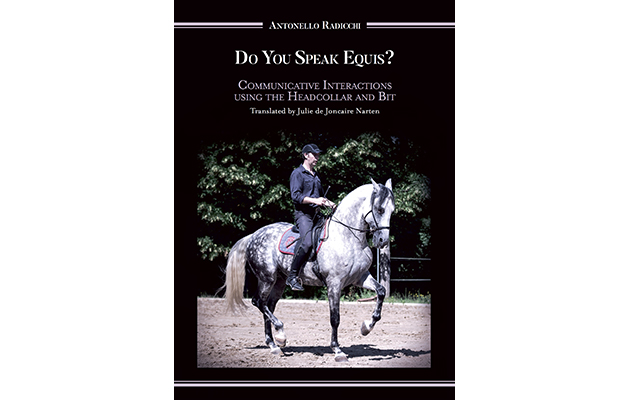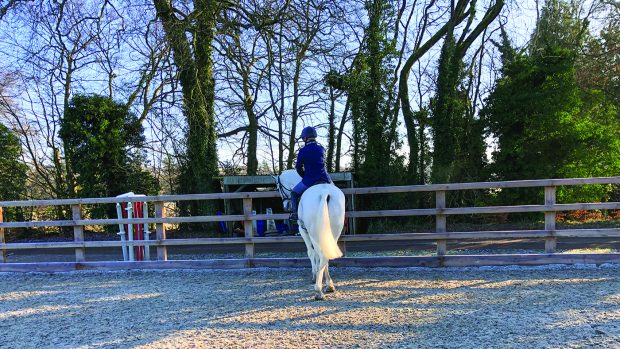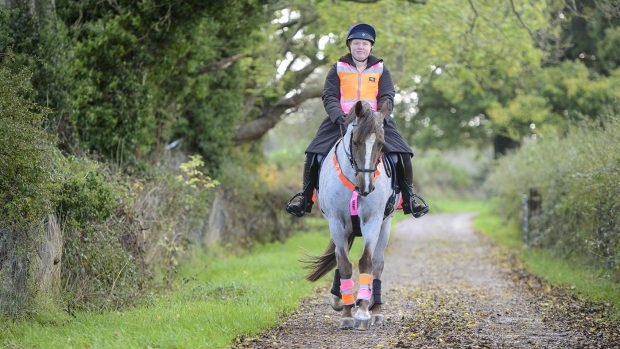In his new book Do You Speak Equis? Antonello Radicchi, one of Italy's foremost horse trainers, looks at methods of communicating with your horse, based on mutual understanding and reciprocal respect
When I start to interact with a horse, I first try to understand his character. Is he curious, suspicious, tolerant …?
I make a first assumption, based on observing him at liberty and then, on this hypothesis, I start to build a work plan with him, either confirming such initial hypothesis, or changing it all completely, depending on his behaviour, which will reveal itself as the work progresses.
The important thing is not to fix ourselves on an initial idea; we have to be ready to change, adapting to it, without prejudice.
Let’s suppose that we have entered the ring and that we find ourselves at the centre of it while our friend, on the other hand, is standing nice and quiet at the furthest point, not even gracing us with a look — in fact, turning his attention to the outside, as if we didn’t exist or simply because something more interesting is happening out there.
What does he make of us?
I don’t know, but definitely not something to interact with and even less as his leader. This is no good.
Things have to change. You will have no doubt noticed what happens, for example, when two horses who do not know each other and who are never normally together are put outside in the open: they approach each other, they sniff each other and after that, one of the two subjects ‘imposes’ on the other to go away, to back off, to concede space, more or less depending on the level of aggression. A few seconds and the hierarchy is established.
If we carefully analyse what has happened, in order to understand the two horses, we will need to comprehend how the dominant one places himself in respect of the dominated one so as to reproduce his intent.
To simply imitate their physical attitudes without a deep conviction of the act is completely useless, and, especially when we are dealing with an aggressive individual, it can be dangerous, but we will deal with this particular matter later. Don’t even think about ‘educational punishment’: it does not exist.
Only the conditions of dominating or being dominated exist and we should always remember that, to dominate, all we need to do is to make the horse move a bit. We must have the knowledge of the attitudes of the dominated, without which we would not have the basis on which to carry out our actions.
Let’s see their respective attitudes.
The dominant horse has:
• Ears pulled backwards
• Mouth open with teeth protruding with the intent to bite and charge
• A tail that swishes restlessly
• A back end that turns ready to kick
Whereas the dominated horse:
• Yields to pressure, conceding space
• Tends to follow the dominant subject, paying him attention
Clearly this is a simple and incomplete description, which is intended to allow us to recognise potentially dangerous attitudes (safety first). To succeed in understanding the real motivations behind these attitudes is, and will always be, the objective of reciprocal understanding.
Often, aggressive attitudes can hide fear or uncertainty, anxiety and so on and only with time, without excluding anything at first glance will we be able to accustom ourselves to that particular horse and consequently assume the appropriate attitudes with him. We don’t need to be psychoanalysts; it will suffice, as always, to show sane common sense.
One day, a dear friend told me the difference between dominance and authority, explaining that dominance is obtained through submission whereas authority derives from recognition of what we are and what we do. It is clear then that we cannot, in any way, oblige a horse to accept our authority and that, for this to happen, we need to earn this acceptance.
A horse is a herd animal and will therefore willingly accept to be led provided that he recognises in us the characteristics required of a leader.
Theirs is not blind faith and the fact that the horse obeys us is not a consequence of collaboration.
Obedience can be induced by submission, but collaboration can only be achieved by obtaining their esteem and respect.
Only thus can our authority be recognised. I would need another book to deal only with this topic, which is so rich in fascinating nuances, but my hope resides in the fact that, with time and practice, readers can find the best path towards establishing at least a balanced rapport with their horses. One can give guidelines but their direct application will nonetheless have to be personalised.
Clearly, personalising does not mean adapting a form of communication to one-self, but rather mastering it to the point of feeling it one’s own way and adapting the expressive requirements to the numerous variables, which we will inevitably encounter in interacting with horses. The ability to shape communication and adapt it to the common requirements in an attempt to create a rapport which is firmly based on reciprocal collaboration can only come with time.
Experience is, in many cases, a teacher who cannot be replaced. A correct study, and a suitable practice carried out under the guidance of a good teacher, are only meant to shorten the learning curve, which will also be determined by personal ability, but there are no short-cuts.
The risk of being misunderstood is part of the game, but I would ask only one thing of anyone trying to benefit from the hints which this book can offer: ‘always use common sense’ in both your interests and the horse’s. Aggression as an end in itself is never a good path to follow; it can only make sense if it is used to re-establish the parameters of safety, harmony and lightness.
To be able to initiate any interaction, we need to get the horse’s attention. How do we do this?
Continued below…

Natural horsemanship: ‘just good, common sense horsemanship’ or something else?

Parelli Natural Horsemanship: what’s the verdict?
This month marks the 35th anniversary of Pat
THE WHAT AND THE HOW
The ‘what to do’ depends strictly on the horse’s reactions, whilst the ‘how to do it’ follows strict guidelines.
Hence, the ‘what to do’ (that is, make him go forward, change direction and gait, as well as the intensity and number of our requests) depends directly on the reactions of the horse, on how he learns, on his character, on the environment and so on and must necessarily be interpreted on the spur of the moment.
The ‘how to do it’, on the other hand, will fortunately be subject to rules that have been clearly drawn up and established by the grammatical structure of the language.
Therefore, observing a horse’s reactions will determine our actions. The intensity of the pressure will be linked to these same reactions, and to know how to judge the correct reactions will be the parameter we will always have to follow.
We will have to judge and act. Awareness and justice; awareness in judging and acting without delay in the most appropriate way, that which is just.
We have said that the ‘what to do’ can be chosen, whilst the ‘how to do’ follows rigid rules to which we must adhere. Let’s say then that we want to send the horse forwards.
It doesn’t matter at the moment in which gait, but let’s just tell him that he has to go away from the place where he is, moving himself forwards.
The ‘what’ is resolved, now let’s see how.
When we ask something, we apply a pressure, therefore from now on, request or pressure will be the same thing.
The pressure that we apply is not, in this context, manifest in physical contact, but rather to the horse’s reaction, with which he manifests his acknowledgement of the same. Confirmation of the correct response, or anyway of a response in line with the request, should be given by the immediate interruption, or clear lessening, of the request or pressure (descent of aids).
The repetition and interruption of the request and therefore of the pressure in one or more given situations, where these criteria correspond to a given response or gesture by the horse, will be interpreted by him as a response to the pressure because the pressure ceases at the very moment of the positive reaction (response). The consequential logic of all this is an association — that is to say that a particular response becomes ‘associated’ with that particular request.
We are teaching. And he who teaches, learns.
And this is the concept of the ‘comfort zone’ and the ‘discomfort zone’, where the zone must be understood both in a physical and abstract manner; that is, in an abstract manner as the learning of a concept not linked to place, and in a physical manner as a place linked to the concept.
Let’s try to understand this better.
If we want to teach the horse to do a lateral flexion of the neck (clearly at our request, since he has been capable of doing it on his own since birth), we should apply pressure until the horse starts to yield and flexes in the requested direction. Therefore ‘pressure-reply-yield’ and the resulting attainment of comfort. In this case, we have sought a certain movement in line with our request, not by a conditioned association but through a link between a ‘comfortable zone’ and a place.
We will now talk about an ‘uncomfortable zone’, linked instead to a physical place. For example, in the ring, the horse runs off to a certain zone – who knows, maybe because there is a tractor parked nearby and he darts off, increasing his speed at each step until he finally adopts a more serene attitude when he gets away from it.
So by the tractor is the discomfort zone; away from the tractor is the comfort zone. This, at least, until we decide to intervene and invert things, applying pressure to the horse in his comfort zone (where he seeks to relax), and taking it away as soon as the horse enters his discomfort zone.
He will thus find himself in a stalemate situation: between a discomfort caused by the tractor but without real danger and a discomfort zone caused by us. If we do not yield, he will be forced to change his parameters for getting out of a difficult situation. As he deals with the problem and understands that there is no real danger, that will become his comfort zone, where he will tend to slow down until he stops, which we, of course, will more than willingly allow. The physical comfort zone.
The concept is always the same, and always will be. The structure of the language does not change; the intent does.
Do You Speak Equis? by Antonello Radicchi is published by The Crowood Press
Price: £25
Visit: crowood.com

For all the latest equestrian news and reports, don’t miss Horse & Hound magazine, out every Thursday




